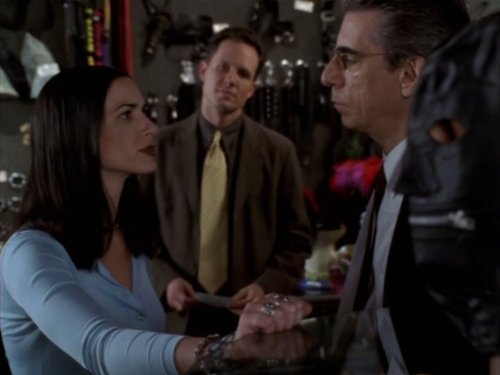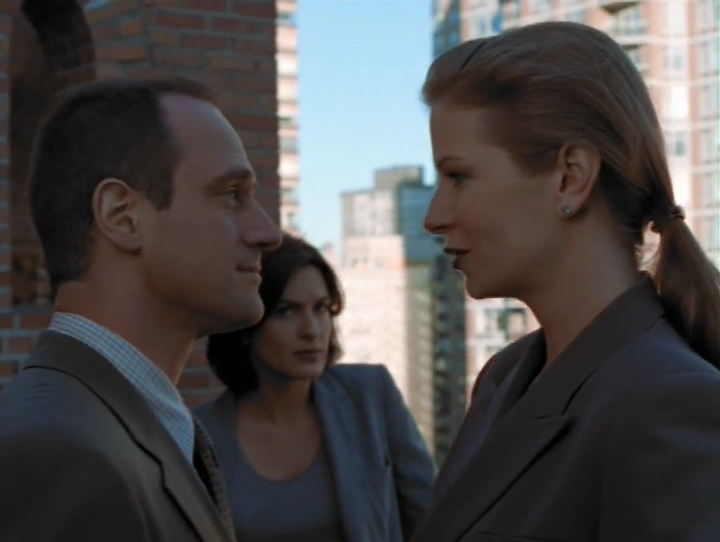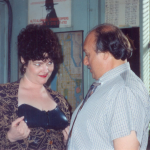“Stocks & Bondage” First aired November 29, 1999 IMDB
“Stocks & Bondage” opens with a familiar scene: a woman found dead in bondage gear. However, as the detectives investigate, the case turns out to be more about shady financial dealings on Wall Street than sexual deviance.
“Stocks & Bondage” includes some of the same tropes as the earlier Law & Order episode “Prisoner of Love”, particularly the discussion over whether the death that started the story is an accident, a suicide, or a murder. Unlike the dual focus on detectives and prosecutors of its parent series, Special Victims Unit is mostly about the investigation, not the legal complexities.

The detectives react to the victim’s multiple piercings with some jocular teasing about the tattoos on Detective Stabler’s arms.
Cassidy: “I don’t get S&M. I mean, ‘Hurt me, that turns me on?’ Come on, what’s up with that?”
Munch: (to Benson & Stabler) “It starts with the tattoos. Once you get the ink, It’s just a matter of time before you’re begging to be tied up, spanked.”
Cassidy: “Yeah. Tattoos are just a gateway to the sexual darkside my friend.”
Stabler: (shows off his tattooed arms) “You guys have finally figured me out, huh?”

At All Due Restraint, Munch and Cassidy investigate the bondage equipment Layla purchased on her company credit card.
Proprietor: “I know her. But for obvious reasons we try to protect the privacy of our customers, because the world can be so judgemental of human behaviour.”
Cassidy: “Not us. We leave that to the prosecutors.”
Munch: “What was your sense of Layla?”
Proprietor: “My sense of her? First timer. A little shy. A yuppie with a wild streak. Not much more than that. Why?”
Cassidy: “We found her dead. Trussed up like a latex turkey.”
Proprietor: “My god! We talked about code words, safe play techniques, and so on.”
Cassidy: “I guess that lesson didn’t stick so well, did it?”
Forensic examination of the victim revealed a lot of marks, which leads to some glib psychoanalysis.
Benson: “The victim had several self-inflicted wounds, or at least willingly endured wounds.”
Stabler: “Which raises the possibility that this is neither suicide nor homicide.”
Cragen: “What, rough sex gone awry? That’s the kind of explanation you get from defense attorneys.”
Benson: “Hey, it happens. This girl was into some pretty serious paraphilias. She was pierced from head to toe.”
Cragen: “What, and you’re telling me she works on Wall Street?”
Benson: “Investment analyst.”
Munch: “Those two worlds overlap more than you might think.”
Jeffries: “What two worlds, S&M and high finance?”
Munch: “Oh yeah, the all-consuming obsession to destroy political competitors is no different than the compulsion to harm one’s fellow man.”
Benson: “Or woman.”
The victim’s mother provides a diversion, in that she was so ashamed of discovering her dead daughter in bondage that she covered up the body with a robe and threw the bondage gear into the trash. (Actually, the opening teaser plainly showed lingerie and bondage gear at the crime scene.)

There’s a panning shot of the gear and toys recovered. The detectives dismantle one of the unused floggers in Layla’s apartment and discover it contains about half a million dollars worth of diamonds.
This connects to the shady financial company where she worked, and the Wall Street guy Frank Martin who runs it. It’s not only about money. Frank uses his control over his female employees to further his business plans, offering their sexual favors in addition to or in place of bribes and kickbacks. Failing that, there’s always the old “badger game” of maneuvering the mark into a sexually compromising position.
David Kelp, who runs a charity that’s mostly for money laundering, reveals how he got into this to the detectives.

David Kelp: “We [he and Layla] shared certain compulsions. I tried but I was never entirely able to relieve myself of them.”
[Rolls up his sleeve to reveal cigarette burns on his arm, as well as a barbed wire tattoo.]
David Kelp: “Layla knew me as the human ashtray. We met on the Circuit. The non-profit world is very concerned with appearances.”
Benson: “And she threatened to expose you.”
David Kelp: “Unless I helped her. And when I helped her once, and that was the thin end of the wedge.”

That leads to Anna Faust, strongly implied to be a pro-domme and/or madam. Faust says she threw Layla and her dominant, Frank Martin, out of her party because Frank hurt one of her girls. This was a Vietnamese immigrant who was in the country illegally, which Frank later used to extort sex from her. He choked her unconscious, and was gone when she woke up.
At this point, Frank and his accomplices go into hiding, and the detectives have to track them down. One of them, Amy, talks to the detectives.
Amy: “He [Martin] was always in control. Little did I know.” […] “See, I don’t mind a little recreational spankies, tying up, playful stuff. So he quickly lost interest in me. He liked the thrill of controlling women who struggled against him. Sick bastard. He said that he and his homeboy Tucker used to tie farm girls to trees and then just sit in the woods just laughing. Getting off on watching them struggle.”
Frank and Tucker each attempt to pin the death of Layla on the other, but the detectives charge both of them.
The case stakes a hard turn from being about sex to being about money, then turns back into being about sex. At the last moment, there is another sharp turn into being about race. It suggests that Tucker and Martin’s abuse of women was fostered in the South, with a joint history of tying “colored girls” to trees and tormenting them, as if no Northern man would ever do such things. Detective Monique Jeffries (Michelle Hurd), a woman of color who has barely been involved in the case, suddenly comes in to insult the suspects, calling them “rednecks”.
Frank Martin was based on real-life financial criminal Martin Frankel, who did keep a “harem” of women who lived with and worked for him in a Connecticut mansion, and shared (or at least tolerated) his interest in sadomasochism. When one of the women hung herself in 1997, “detectives noted in a police report that bondage videos, ropes and a leather riding crop were found in Frankel’s house.” He recruited them by posting ads in the Village Voice.
It’s no secret that there are predatory people in the BDSM world, and they may overlap with other criminal activity. The proprietor of the bondage shop made a perfunctory statement regarding safety and consent, but SVU is not interested in exploring the line between BDSM and abuse. Furthermore, there’s no particular link between Martin’s financial crimes and his sexual interests. Plenty of financial criminals have only vanilla tastes.
Compared to other procedural show episodes that touch on BDSM (or later seasons of SVU), “Stocks & Bondage” is fairly restrained. There is no voyeuristic scene of the detectives entering a BDSM club, and the interviews with sex workers aren’t sensational. However, Cassidy, a younger detective, does leer at the female proprietor of the bondage shop (who, contrary to stereotype, is not dressed in fetish wear) and has to be pulled away by his partner. (Not the kind of behavior you want to see in a person who has to work with rape victims and the like.)




[…] treads some of the same ground as “Stocks & Bondage”, earlier in the first season, as the primary antagonist is a man who psychologically controls […]